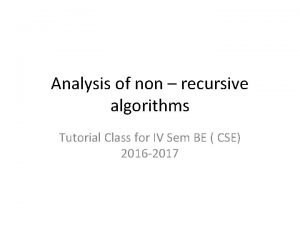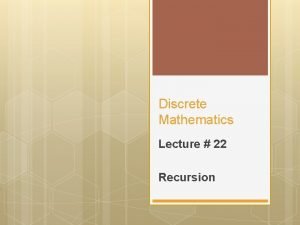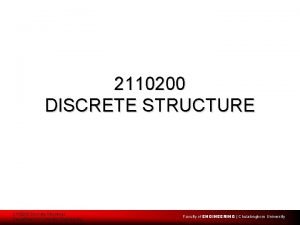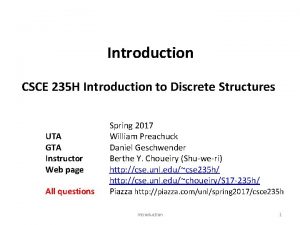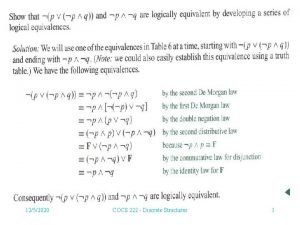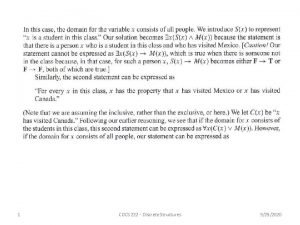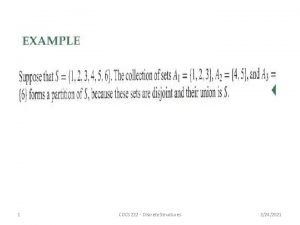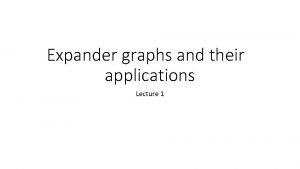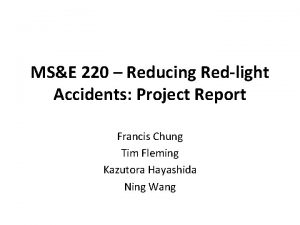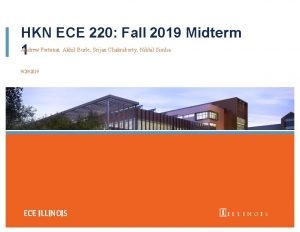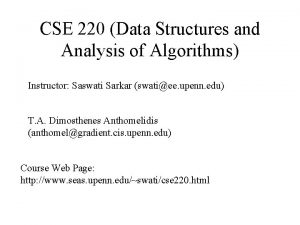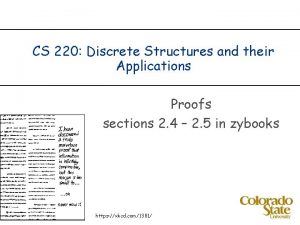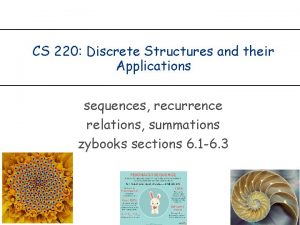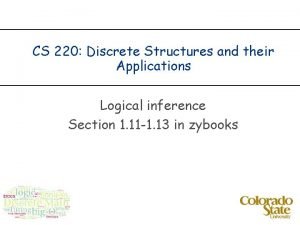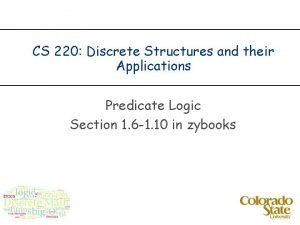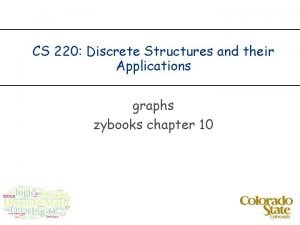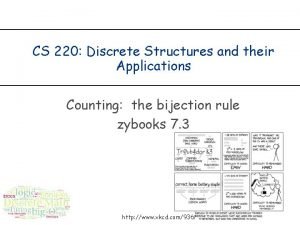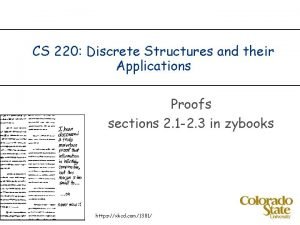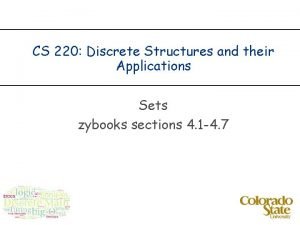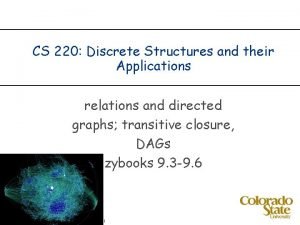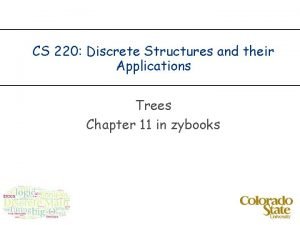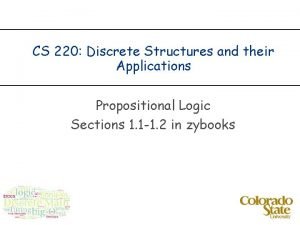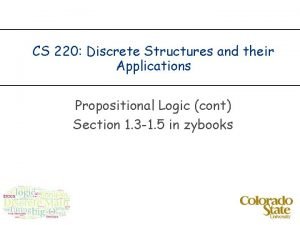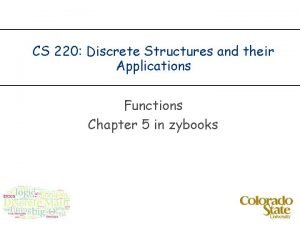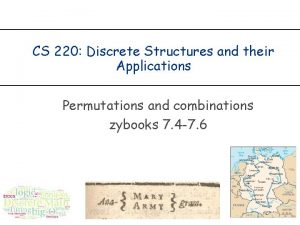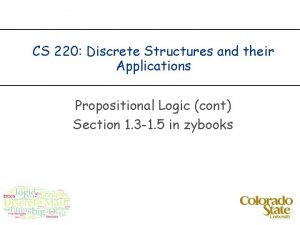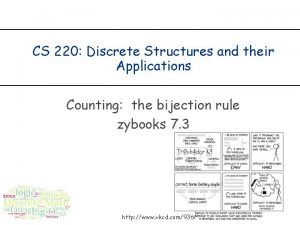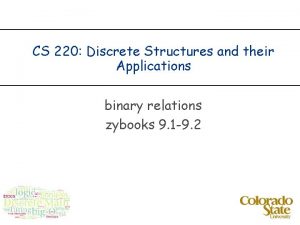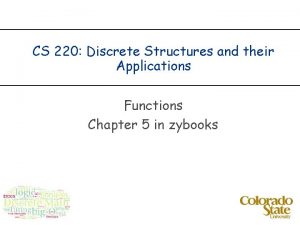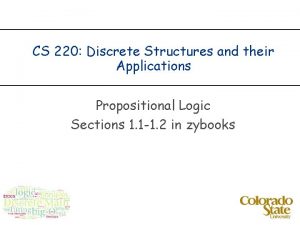CS 220 Discrete Structures and their Applications Recursive





















- Slides: 21

CS 220: Discrete Structures and their Applications Recursive objects and structural induction 6. 9 – 6. 10 in zybooks

Using recursion to define objects We can use recursion to define functions: The factorial function can be defined as: n! = 1 for n = 0; otherwise n! = n (n - 1)! This gives us a way of computing the function for any value of n.

factorial This is all we need to put together the function: def factorial(n): # precondition: n is an integer >= 0 if (n == 0) return 1 else : return n * factorial(n-1);

recursive sets Some sets are most naturally specified by recursive definitions. A recursive definition of a set shows how to construct elements in the set by putting together simpler elements. Example: balanced parentheses (()(())) is balanced ()) and ())()(() are not

recursive sets Some sets are most naturally specified by recursive definitions. A recursive definition of a set shows how to construct elements in the set by putting together simpler elements. Example: balanced parentheses Basis: The sequence () is properly nested. Recursive rules: If u and v are properly-nested sequences of parentheses then: 1 (u) is properly nested. 2 uv is properly nested.

recursive sets Example: balanced parentheses Basis: The sequence () is properly nested. Recursive rules: If u and v are properly-nested sequences of parentheses then: 1 (u) is properly nested. 2 uv is properly nested.

balanced parentheses Basis: The sequence () is properly nested. Recursive rules: If u and v are properly-nested sequences of parentheses then: 1 (u) is properly nested. 2 uv is properly nested. Is there a unique way to construct ()()() ?

recursive sets Some sets are most naturally specified with recursive definitions. A recursive definition of a set shows how to construct elements in the set by putting together simpler elements. The basis explicitly states that one or more specific elements are in the set. Recursive rules show to construct more complex elements from elements already known to be in the set.

binary strings Let B = {0, 1} Bk: the set of binary strings of length k: {0, 1}k The empty string: λ B 0 = {λ} The set of all binary strings:

binary strings The set of all binary strings: This set can be defined recursively: Base case: λ ∈ B* Recursive rule: if x ∈ B* then ü x 0 ∈ B* ü x 1 ∈ B*

strings Example: length of a string Let Σ be an alphabet The length of a string over the alphabet Σ can be defined recursively: l(λ) = 0 l(wx) = l(w) + 1 if w ∈ Σ* and x ∈ Σ

perfect binary trees Basis: A single vertex with no edges is a perfect binary tree. Recursive rule: If T is a perfect binary tree, a new perfect binary tree T' can be constructed by taking two copies of T, adding a new vertex v and adding edges between v and the roots of each copy of T. The new vertex v is the root of T'.

perfect binary trees Basis: A single vertex with no edges is a perfect binary tree. Recursive rule: If T is a perfect binary tree, a new perfect binary tree T' can be constructed by taking two copies of T, adding a new vertex v and adding edges between v and the roots of each copy of T. The new vertex v is the root of T'.

structural induction We can use induction to prove properties of recursively defined objects. This is called structural induction. As an example, we'll prove the following: Theorem: Properly nested strings of left and right parentheses are balanced. A string of parentheses x is called balanced if left[x] = right[x], where left[x] (right[x]) is the number of left (right) parentheses in x. In fact, they are more than balanced (as defined above).

structural induction Theorem: Properly nested strings of left and right parentheses are balanced. Proof. By induction. Base case: () is properly nested. left[ () ] = right[ () ] = 1.

structural induction Inductive step: If x is a string of properly nested parentheses then x was constructed by applying a sequence of recursive rules starting with the string (). We consider two cases, depending on the last recursive rule that was applied to construct x. Case 1: Rule 1 is the last rule applied to construct x. Then x = (u), where u is properly nested. We assume that left[u] = right[u] and prove that left[x] = right[x]:

structural induction Inductive step: If x is a string of properly nested parentheses then x was constructed by applying a sequence of recursive rules starting with the string (). We consider two cases, depending on the last recursive rule that was applied to construct x. Case 2: rule 2 is the last rule applied to construct x. Then x = uv, where u and v are properly nested. We assume that left[u] = right[u] and left[v] = right[v] and then prove that left[x] = right[x]:

number of vertices in a perfect binary tree Theorem: Let T be a perfect binary tree. Then the number of vertices in T is 2 k - 1 for some positive integer k. v(T): the number of vertices in T

number of vertices in a perfect binary tree Theorem: Let T be a perfect binary tree. Then the number of vertices in T is 2 k - 1 for some positive integer k. Proof. By induction. Base case: the tree with one vertex has 21 – 1 = 1 leaves

number of vertices in a perfect binary tree Theorem: Let T be a perfect binary tree. Then the number of vertices in T is 2 k - 1 for some positive integer k. Inductive step: Let T' be a perfect binary tree. The last recursive rule that is applied to create T' takes a perfect binary tree T, duplicates T and adds a new vertex v with edges to each of the roots of the two copies of T. We assume that v(T) = 2 k 1, for some positive integer k and prove that v(T') = 2 j - 1 for some positive integer j.

number of vertices in a perfect binary tree Theorem: Let T be a perfect binary tree. Then the number of vertices in T is 2 k - 1 for some positive integer k. The number of vertices in T' is twice the number of vertices in T (because of the two copies of T) plus 1 (because of the vertex v that is added), so v(T') = 2·v(T) + 1. By the inductive hypothesis, v(T) = 2 k - 1 for some positive integer k. Therefore v(T') = 2·v(T) + 1 = 2(2 k - 1) + 1 = 2· 2 k - 2 + 1 = 2 k+1 – 1
 Recursive and non recursive algorithm
Recursive and non recursive algorithm Recursive definition of odd positive integers
Recursive definition of odd positive integers Homologous
Homologous Proof by contradiction discrete math
Proof by contradiction discrete math 2110200
2110200 Webhandin unl
Webhandin unl Discrete computational structures
Discrete computational structures Discrete structures
Discrete structures Discrete structures
Discrete structures Discrete structures
Discrete structures Applications of propositional logic
Applications of propositional logic A computer programming team has 13 members
A computer programming team has 13 members N-ary relationship example
N-ary relationship example Expander graphs and their applications
Expander graphs and their applications Which insulating material is used in circuit breaker
Which insulating material is used in circuit breaker Prolog of romeo and juliet
Prolog of romeo and juliet Pound to kg equation
Pound to kg equation Animated calculator
Animated calculator Definer 220
Definer 220 Kazutora hayashida
Kazutora hayashida Uiuc ece 220
Uiuc ece 220 Cse220
Cse220
